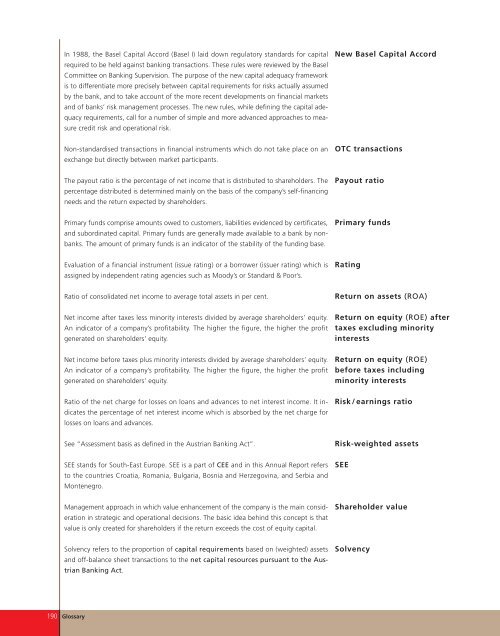team spirit - Bankier.pl
team spirit - Bankier.pl
team spirit - Bankier.pl
Create successful ePaper yourself
Turn your PDF publications into a flip-book with our unique Google optimized e-Paper software.
In 1988, the Basel Capital Accord (Basel I) laid down regulatory standards for capital<br />
required to be held against banking transactions. These rules were reviewed by the Basel<br />
Committee on Banking Supervision. The purpose of the new capital adequacy framework<br />
is to differentiate more precisely between capital requirements for risks actually assumed<br />
by the bank, and to take account of the more recent developments on financial markets<br />
and of banks’ risk management processes. The new rules, while defining the capital adequacy<br />
requirements, call for a number of sim<strong>pl</strong>e and more advanced approaches to measure<br />
credit risk and operational risk.<br />
Non-standardised transactions in financial instruments which do not take <strong>pl</strong>ace on an<br />
exchange but directly between market participants.<br />
The payout ratio is the percentage of net income that is distributed to shareholders. The<br />
percentage distributed is determined mainly on the basis of the company’s self-financing<br />
needs and the return expected by shareholders.<br />
Primary funds comprise amounts owed to customers, liabilities evidenced by certificates,<br />
and subordinated capital. Primary funds are generally made available to a bank by nonbanks.<br />
The amount of primary funds is an indicator of the stability of the funding base.<br />
Evaluation of a financial instrument (issue rating) or a borrower (issuer rating) which is<br />
assigned by independent rating agencies such as Moody’s or Standard & Poor’s.<br />
Ratio of consolidated net income to average total assets in per cent.<br />
Net income after taxes less minority interests divided by average shareholders’ equity.<br />
An indicator of a company’s profitability. The higher the figure, the higher the profit<br />
generated on shareholders’ equity.<br />
Net income before taxes <strong>pl</strong>us minority interests divided by average shareholders’ equity.<br />
An indicator of a company’s profitability. The higher the figure, the higher the profit<br />
generated on shareholders’ equity.<br />
Ratio of the net charge for losses on loans and advances to net interest income. It indicates<br />
the percentage of net interest income which is absorbed by the net charge for<br />
losses on loans and advances.<br />
See “Assessment basis as defined in the Austrian Banking Act”.<br />
SEE stands for South-East Europe. SEE is a part of CEE and in this Annual Report refers<br />
to the countries Croatia, Romania, Bulgaria, Bosnia and Herzegovina, and Serbia and<br />
Montenegro.<br />
Management approach in which value enhancement of the company is the main consideration<br />
in strategic and operational decisions. The basic idea behind this concept is that<br />
value is only created for shareholders if the return exceeds the cost of equity capital.<br />
190 Glossary<br />
New Basel Capital Accord<br />
OTC transactions<br />
Payout ratio<br />
Primary funds<br />
Rating<br />
Return on assets (ROA)<br />
Return on equity (ROE) after<br />
taxes excluding minority<br />
interests<br />
Return on equity (ROE)<br />
before taxes including<br />
minority interests<br />
Risk/earnings ratio<br />
Risk-weighted assets<br />
SEE<br />
Shareholder value<br />
Solvency refers to the proportion of capital requirements based on (weighted) assets Solvency<br />
and off-balance sheet transactions to the net capital resources pursuant to the Austrian<br />
Banking Act.
















